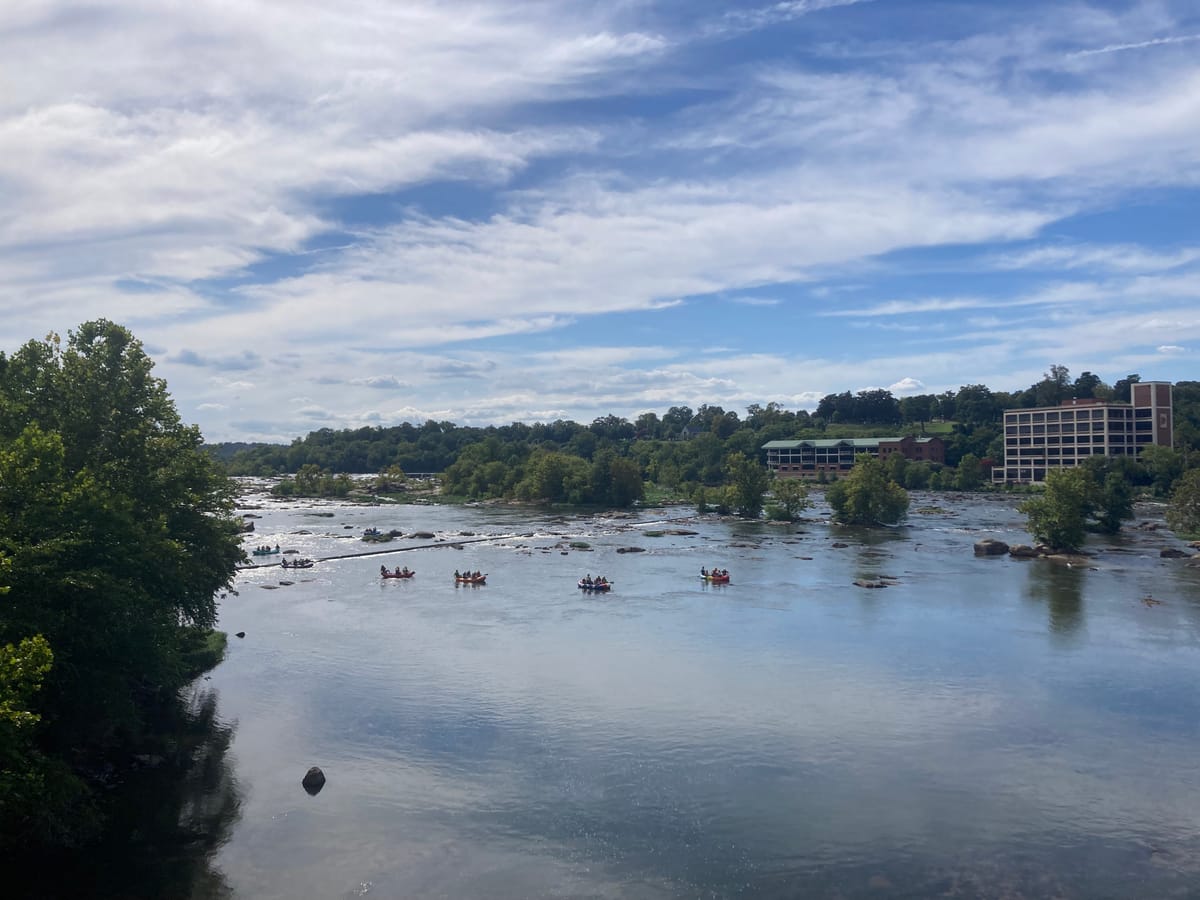
How to float down the James River, safely
It's not called the River City for nothing.
And each year, thousands of people flock to the James to prove that point.
As the only city in the country with Class IV rapids that course through downtown, Richmond brings a unique appeal to boaters, paddlers and floaters alike.
“A lot of places you see mountains. Here in Richmond, we see skyscrapers,” RVA Paddlesports Founder and Instructor Patrick Griffin said.
The most appealing thing for many Richmonders about the James is just that: its proximity to the city and its accessibility.
“For example, I'm gonna go kayaking after work today with a friend,” Griffin offered on a recent day. “At 6 o'clock we both check out of what we're doing at work and we're gonna go on the James and enjoy.”
Richmonders who want to follow suit can do so easily, as long as they are prepared and do their homework, according to Department of Wildlife Resources Boating Division Director Stacey Brown.
Brown grew up on a lake, and said she has always been boating. This translated into a career in boating education, getting other people excited about getting on the water. She has a plaque above her desk that reads, “Sinking is not an Option.”
The Richmonder sat down with Brown, Griffin and other experts to get some tips.
Before you make your plans: 'Do a little bit of homework before you go have fun.'
Things like water level, water quality, and even weather patterns upstream can dramatically change what kind of day you’ll have on the water.
“If there's bad weather in Charlottesville, Western Virginia, if there's been a big rain event, even if it's not raining here, we're going to see, we may have flooding here. And so it's really important to check the water levels all the time,” Brown said.
Resources like the United States Geological Survey that have gages along the James, or the James River Association’s James River Watch are great places for tubers to look according to DWR.
'Go with someone who knows the river'
That can be a friend who’s an avid tuber, or there are companies in town that offer packages.
With rapids ranging from class I to VI, depending on the season, the river changes drastically as it rolls towards downtown.
From the traditional starting points upriver (Pony Pasture or Huguenot Flatwater), there are two very dangerous, and deadly, water obstacles: dams. Bosher’s Dam and the Z Dam are two low-head dams. Low-head dams are unique because they appear to be flat water. While the Z Dam does not go all the way across the James, it is difficult for the untrained eye to know where it ends.
“You don’t even see that there's a dam,” Brown warned potential solo boaters and floaters. “Low head dams are very, very dangerous. We did have a fatality on the low head Bosher’s Dam a couple years ago.”
Brown said boaters will see signage for the dams at all load-in spots, but it's tricky to anticipate them without a guide or someone who is familiar with the river.
The best advice for people looking to stay safe is to travel with someone who has been on the James before and really knows the river.
Go in and out with the tide
It might sound obvious, but float with the water, not against it!
According to Brown, the James in the summertime is “a 24-hour boating scene,” in particular for recreational floaters.
“I don't think it matters the time of day. If you're smart, you'll probably get up really early to try to beat the crowd and beat the parking lot, but I’m not sure it's gonna work.”
DWR workers and Richmonders tend to agree that the best spots to start from are Pony Pasture (7300 Riverside Dr, Richmond, VA 23225), and Huguenot Flatwater (8600 Southampton Rd., Richmond, VA 23235)—two free (and often filled-up) parking lots. GRTC has a drop-off point within walking distance of Pony Pasture.
One popular route is from Huguenot Flatwater to Pony Pasture, while tubers who put in at Pony Pasture will want to get out at Reedy Creek (4101 Hillcrest Rd., Richmond, VA 23225) before the intense rapids of downtown.
Never go it alone
This tip helps with both logistics and safety. As you float down the river, the place you emerge will not be the place you entered from. So it's helpful to have one person park their car at the end of your run, while one of the cars takes you to the start. If traveling without a guide or group, it will require a bit of logistics before making a splash. Brown’s rule? Two people, two cars.
According to Brown, boating on the river can get intimidating due in part to all of the logistics—where to park (Pony Pasture is a preferred spot), where to get out (before the city if you don’t have a raft or guide), and where to avoid (invisible dams along the river). Having a friend or a professional who knows their way around then, is essential.
Wear a life vest! (or a PFD—Personal Flotation Device)
In 2024 there were 17 fatalities in Virginia due to drownings, 16 of which were people who were not wearing a life vest, according to DWR Public Information Officer Shelby Crouch.
Brown likened the lifevest to a seatbelt.
“Even though you could be the best driver in the world, somebody else may not be. It's similar on the water,” she said.
The life vest you choose depends on personal preference and what activity you intend to partake in on the water.
Vests like Crouch’s purple one are great for kayaking, as is the rescue blade she keeps with her on all times. Crouch has capsized multiple times and sees the life vest as an essential ingredient in the journey. For paddlers who are more sensitive to the feeling of a hot vest on a summer day, they might opt for something like the Mustang, a life vest that inflates like the type on airplanes, when you pull the yellow string. Crouch and Brown suggest paddlers fasten a whistle, like the orange ones pictured above, to their PFDs so they can call for help if needed.
Oftentimes, according to Griffin, whitewater life vests have more floatation and a pillow on the back for more adventuresome risk takers. Flat water boaters typically are given special flat water life vests with mesh backs that make sitting in the boats more comfortable.
According to Griffin it's not just important to wear a life vest, but it also matters that it fits correctly.
Protect your feet (and your body)!
Brown and Crouch recommend wearing shoes, something RVA Paddlesports requires of its customers, to protect your feet from rocks and debris.
Another important step, if you fall out of your tube or boat, is to float feet-first. That way your feet act as the buffer.
“If you're free flowing, you want to go feet first and feet up, because if you hit a rock or you hit debris, you want to hit it with your feet, not your head,” Crouch said.
Finally, when it comes to feet in the river, try to keep them up and away.
“It's an inherent kind of thing that you want to try to stand up, especially if you're in a shallow spot. But if that water is really moving and you've got a lot of debris on the bottom, you could get a foot stuck,” Brown warned.
Tell people your plans
Tell someone when you plan to return from the water so they know if, and when to worry. Know who to call if something goes wrong, too.
Ultimately, Brown said, “we’re not the Fun Police.”
“We want to have fun. We want to enjoy it. That's our goal, to encourage people to go outside. Enjoy the outdoors, hunt fish, recreate, go bird watching, do all the things, but we want you to do it safely. It's way more fun if your life isn't at risk.”
Contact reporting intern Juliana Vandermark at jvandermark@richmonder.org.
The Richmonder is powered by your donations. For just $9.99 a month, you can join the 1,000+ donors who are keeping quality local journalism alive in Richmond.






